Students’ 'Ghostwalk' invites listeners on a spooky campus tour
Western students have populated the Bellingham campus and Sehome Arboretum with ghosts – or at least, ghost stories.
Students in English Instructor S. Hayley Steele’s Mixed Genre Writing class picked particular spots on campus and created an idea for a ghost that could linger there. “Ghostwalk: A Creative Haunting of Sehome Hill,” is a collection of the poems, stories, songs and radio plays the writing students produced with the help of audio engineering students in Ezra Anisman’s Intro to ProTools class in Fairhaven College of Interdisciplinary Studies.
“Ghostwalk” uses GPS data to link the ghost stories to the locations that inspired them so listeners can hear pieces as they visit each connected place. The collection is on the Gesso.fm app, and can also be streamed online at https://gesso.fm/collections/ghost-walk.
Steele describes the Ghostwalk as an open mic event that has been scattered across place and time, with the app tethering each poem, story, song, or radioplay to the location that inspired it.
“It’s speaking to you, saying something about the place you’re at and it’s almost a puzzle or a mystery for some of them,” she said. “It’s been so fun to see how everybody took the ghost prompts in very different directions.”
The students created ghosts that lurk in places like Fisher Fountain, the Outback Farm, the pond at Fairhaven College and the Viking Union bus stop. Some of the Halloween-themed stories are creepy or scary, while others are introspective and sincere. They all explore the ideas of haunting, place and impermanence.
“I was less drawn to the feeling of a creepy ghost and more to the idea of a ghost being the embodiment of a prolonged existence, of some spirit or form that lives outside of time,” said Carina Rafaelli, whose ghost haunts the “Stone Enclosure: Rock Rings” sculpture.
Aliyah Kennedy’s ghost lurks in the Sehome Arboretum, mired in the emotional turmoil of a difficult breakup.
“There is something very beautiful about locative art,” Kennedy said. “Initially you may never notice there is a story with every coordinate in the world, but the world is full of memories.”
A.J. Deford’s piece takes place at the stage in the Outback Farm, their favorite place on campus, with walls graffitied with messages from throughout the years that range from silly to meaningful. When they went to work on the ghost walk project, they discovered a message that they described as a prayer for the next person to find it, asking them to treat the stage with respect and talking about what a magical place it was.
“When I went out there to write a ghost, I had a completely different project in mind,” Deford said. “It felt a little silly of me to make up a ghost for the stage when it was already haunted by all these words that were there. I couldn’t help but reflect and muse and write about that instead. It just kind of flowed out of me.”
The creative process for this ghost story felt different to Deford, compared to previous works that were focused on meeting the parameters of a specific assignment.
“This piece really was an emotional unload of everything I felt when I was at that stage,” Deford said. “It was less I had to sit down and think how I wanted it to sound exactly and more I just let loose everything I was feeling and then cleaned it up.”
Once the students created their stories, they recorded them with Anisman’s students, who mixed them and created a soundscape to complement the piece. Steele described listening to the final stories with her mouth agape, shocked by how different the experience was compared to when she read the stories earlier in the quarter.
“There’s something about that extra layer of having another creative person take the writer’s work and use sound to try open the world of it up,” Steele said. “It got me noticing lines and turns of phrase and imagery that I hadn’t seen or connected to before.”
Steele hopes this experience will give students who haven’t been able to get their work out the world during the last two and a half years of the pandemic an opportunity to share their work with the public. Because the Ghostwalk is a permanent installation, the pieces can be enjoyed long past Halloween.
“For me, it was like I got to leave my own piece of graffiti on the stage. That was a bit of an honor for me to add my voice to the many others out there.” Deford said. “It would be really impactful to me to be seen as another Western student leaving their mark in this spot.”
Steele agreed.
“Here’s to leaving our marks but also being present in what it is now.”
